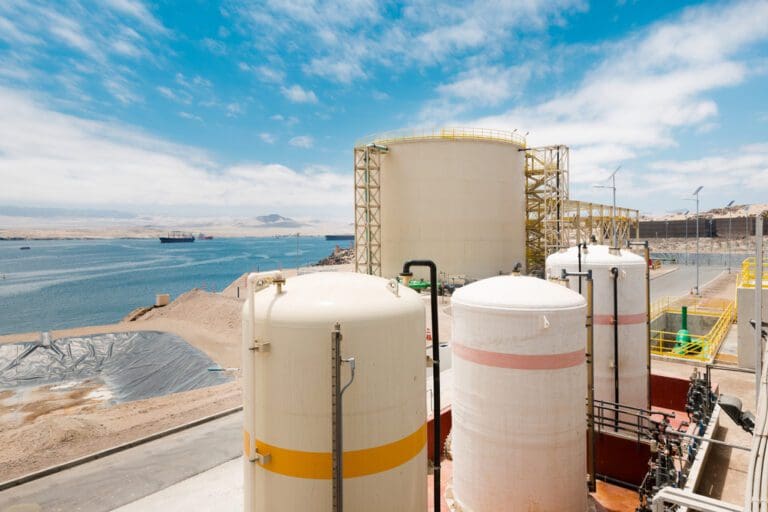Samuel Taylor Coleridge’s classic poem the Rime of the Ancient Mariner contains the oft-quoted line: ‘Water, water everywhere; nor any drop to drink’.
Penned in the late 18th century it is perhaps never more relevant than today.
We are, after all, a world where 71% of our surface is made up of water, while a scarcity of clean, drinkable water is becoming an increasing pressure point for many areas – especially in poorer nations.
This, in turn, can also lead to other problems – among them even conflict.
And the situation is likely only to increase due to the climate crisis. It has been predicted 52% of the world’s projected 9.7 billion people – nearly 5 billion – will end up living in water-stressed regions.
President Joe Biden to invest $49 billion in climate-resilient water

Earlier this year, US President Joe Biden’s administration announced it was to invest more than $49 billion in domestic and global action to ensure that equitable access and climate-resilient water and sanitation infrastructure remain a priority both in the US and around the world.
There are many methods to achieve that, but for many years a major investment opportunity has been through desalination plants – a technology first commercially rolled out in the 1950s.
Over the years, the process of filtering out the salt and other contaminants to make it safe has been refined. But it continues to face considerable challenges; it’s expensive, energy intensive and the brine it discharges back into the sea is a pollutant. This is particularly seen with the increasingly popular reverse osmosis approach – more on that shortly.
Water desalination market
According to Adroit Research, the market for water desalination is expected to push $30 billion in 2030 – more than doubling from its value over the course of a decade.
But recent breakthroughs could be set to accelerate alternative solutions; genuine breakthrough technologies which could prove game changers.
Last year, the University of Tokyo used fluorine-based nanostructures to successfully filter salt from water. Compared to current desalination methods, these fluorous nanochannels work faster, require less pressure and less energy, and are a more effective filter.
Associate Professor Yoshimitsu Itoh from the Department of Chemistry and Biotechnology at the University of Tokyo explained:
“There are two main ways to desalinate water currently; thermally, using heat to evaporate seawater so it condenses as pure water, or by reverse osmosis, which uses pressure to force water through a membrane that blocks salt. Both methods require a lot of energy, but our tests suggest fluorous nanochannels require little energy, and have other benefits too.”
As fluorine is electrically negative, it repels negative ions such as the chlorine found in salt. But an added bonus of this negativity is that it also breaks down what are known as water clusters, essentially loosely bound groups of water molecules, so they pass through the channels quicker.
The research teams test confirmed fluorine-based water desalinationmembranes are more effective, faster, require less energy to operate and are made to be simple to use.
But at this stage it has hurdles to overcome – and further research and investment is needed.
Adds the professor:
“At present, the way we synthesise our materials is relatively energy-intensive itself; however, this is something we hope to improve upon in upcoming research. And, given the longevity of the membranes and their low operational costs, the overall energy costs will be much lower than with current methods.
“Other steps we wish to take are, of course, scaling this up. Our test samples were single nanochannels, but with the help of other specialists, we hope to create a membrane around one metre across in several years. In parallel with these manufacturing concerns, we’re also exploring whether similar membranes could be used to reduce carbon dioxide or other undesirable waste products released by industry.”
Desalination plants are most prevalent in wealthy countries – the oil-rich states of the Middle East have invested heavily in them and have developed a strong reliance on them – as well as southern states of America.
Investment opportunities
But poorer nations offer a potentially uncapped market. There, water can revitalise – figuratively and literally – its workforce; propelling industry, creating jobs and wealth and making many currently cash-poor nations able to become self-sustainable. The potential markets they could unlock could be limitless.
Large scale desalination plants come at a high cost, though, prohibitively so for many, primarily due to energy costs and accessibility.
Which is why money and talent has been heavily invested in desalination powered by solar heat in areas where dependable electricity is hard to come by.
However, many such efforts have run into problems with fouling of equipment caused by salt build-up.
MIT (Massachusetts Institute of Technology) researchers have a solution

Earlier this year, a team of researchers at MIT (Massachusetts Institute of Technology) and in China came up with a solution to the problem of salt accumulation — and in the process developed a desalination system that is both more efficient and less expensive than previous solar desalination methods. They claim the process could also be used to treat contaminated wastewater or to generate steam for sterilizing medical instruments, all without requiring any power source other than sunlight itself.
Explains professor of mechanical engineering Evelyn Wang:
“There have been a lot of demonstrations of really high-performing, salt-rejecting, solar-based evaporation designs of various devices.
“The challenge has been the salt fouling issue, that people haven’t really addressed. So, we see these very attractive performance numbers, but they’re often limited because of longevity. Over time, things will foul.”
Many attempts at solar desalination systems rely on some kind of wick to draw the saline water through the device, but these wicks are vulnerable to salt accumulation and relatively difficult to clean. The team focused on developing a wick-free system instead.
“This new approach provides a promising and efficient path for desalination of high salinity solutions and could be a game changer in solar water desalination,” says Hadi Ghasemi, a professor of chemical and biomolecular engineering at the University of Houston. “Further work is required for assessment of this concept in large settings and in long runs.”
Desolenator – Dutch start-up
Dutch start-up Desolenator is behind what it hopes will be the first mass take-up sustainable solar thermal water purification technology system. It aims to solve the problem of producing water at low cost from 100% solar energy.
With offices in Dubai and London, it claims to be able to purify any water source – including seawater, brackish and heavy-metal contaminated – into drinkable water using solar as its energy source.
After a successful trial, it recently signed a partnership agreement with the Dubai Electricity and Water Authority to build a carbon-neutral water purification and desalination system completely reliant on solar.
Others operating in the space include the likes of Canadian firm Oneka Technologies, which earlier in 2023 concluded its latest funding round. It is delivering zero-energy sustainable drinking water from the ocean using expandable wave-powered desalination systems. While Dutch firm Elemental Water Makers uses reverse osmosis but powered by renewable sources.
Another firm, and technology, to be alert to is being progressed by US firm Source which has developed a system which uses the power of the sun to extract clean, pollutant-free drinking water from the air and then mineralises it to deliver premium-quality drinking water.
Conclusion
Desalination is a tried and tested technology – but it comes at a high environmental and financial cost. Given the stress on water supplies, harnessing new technology – some of which may still be some years from becoming a scalable reality to unlock regions struggling to access clean, drinkable water, has enormous potential. The returns, if they prove successful, could be equally as significant. But the bigger issue is that the economic cost may be outweighed by not adopting the latest systems, leaving governments around the world to potentially invest heavily.
Companies to Watch
Desolenator, Oneka Technologies, Elemental Water Makers, Source.








